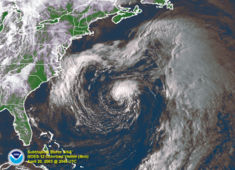Tropical Storm Ana (2003)
2007 Schools Wikipedia Selection. Related subjects: Storms
| Tropical storm ( SSHS) | ||
|---|---|---|
|
Subtropical Storm Ana on April 20, shortly before becoming tropical |
||
| Formed | April 20, 2003 | |
| Dissipated | April 24, 2003 | |
| Highest winds |
|
|
| Lowest pressure | 994 mbar ( hPa) | |
| Damage | None reported | |
| Fatalities | 2 direct | |
| Areas affected |
Bermuda | |
| Part of the 2003 Atlantic hurricane season |
||
Tropical Storm Ana was the first tropical cyclone of the 2003 Atlantic hurricane season, and the only tropical storm on record to exist in the month of April in the Atlantic basin. The storm formed off the coast of Florida and passed south of Bermuda before becoming extratropical. Ana killed two people when ocean swells capsized a boat on the Florida coastline.
Storm history
Like most other tropical storms that develop between December and April, Ana developed from a previously non-tropical low. A weak low on a surface frontal trough developed 305 miles southeast of Miami, Florida on April 16. It drifted eastward and organized into a non-tropical low pressure system on the 18th when an upper-level trough interacted with the front. Under weak steering currents outside of the westerlies, the extratropical low moved northward, where it developed gale force winds on the 19th. The system developed more organized convection, and after the low turned southward late on the 19th, its inner core became more pronounced. Earlier in its life, it was still attached to the front, but when it became detached from the front on April 20, it developed into Subtropical Storm Ana, only the second subtropical storm on record to form in April.
Subtropical Storm Ana drifted east-southeastward, and briefly threatened Bermuda late on April 20, leading to the issuance of tropical storm warnings that were later dropped. Because of a significant upper-level trough over the storm, the storm was subtropical. However, a developing warm core led to the classification of Tropical Storm Ana early on April 21, the only April storm on record. Though convection decreased throughout the day, by the night, Ana had become much better organized. Convection covered the centre, and an eye-like feature was observed on satellite imagery. Based on this, and a QuikSCAT satellite estimate of 65 mph winds, Ana reached its peak of 60 mph with a minimum central pressure of 994 mbar ( hPa) on the evening of April 21.
A ship located 55 miles south of the centre on the night of April 22 directly confirmed the tropical characteristics of Ana. Convection associated with the storm diminished as Ana moved over cooler waters, and upper level wind shear increased over the system. Ana continued to weaken, and became extratropical on April 24 about 885 miles east of Bermuda. As an extratropical storm, Ana continued to the east-northeast. On April 27, what was left of Ana was absorbed by a frontal trough.
Rare formation
When Ana became tropical on April 20, it became the only Atlantic April tropical storm on record (there was a subtropical storm in April of the 1992 season, but Ana was the only April tropical storm in recorded history).
Impact
Tropical Storm Ana produced moderate swells along the coast of Florida. The combination of the swells and an outgoing tide caused a boat to capsize in Jupiter Inlet on April 20. Two of the boat's occupants drowned, while two others were rescued.
On Bermuda, the storm caused sporadic rainfall and gusty winds, though there were no reports of gale force winds.
The name Ana was not retired by the World Meteorological Organization and will be used again for the 2009 season.

